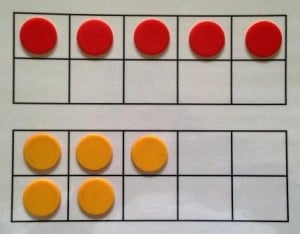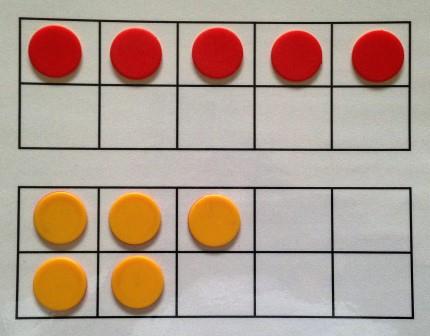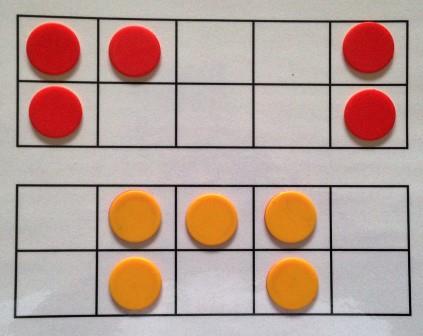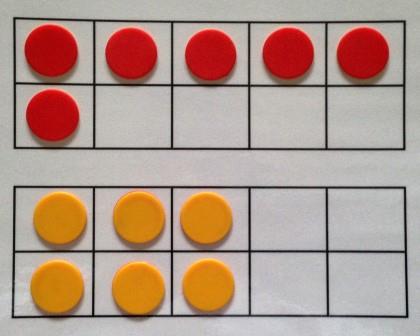by C. Elkins, OK Math and Reading Lady
The focus in this post will be an introduction to ten frames and ways they can help your students gain number sense.  Then stay tuned because ten frames can also be a great tool for addition, subtraction, multiplication, and division.
Then stay tuned because ten frames can also be a great tool for addition, subtraction, multiplication, and division.
Subitizing: This is the ability to recognize an amount without physically counting. Looking at the picture of red counters: If the top row is full, does the student automatically know there are 5? Doing a Number Talk is a great way to practice subitizing using a ten frame:
- Use your own or pre-made dot cards. Flash the card for 1-2 seconds. Observe students. Are any of them trying to point and count? Or do they seem to know right away? Here’s a great video I recommend: KG Number Talk with ten frames
- Tell students to put their thumb in front of their chest (quietly) to signal they know how many there are.
- Ask a few students to name the amount.
- Then ask this very important question, “How did you know?”
- For the top picture you might hope a child says, “I knew there were 5 because when the top row is full, there are 5.”
- For the bottom picture, you might hope for these types of responses: “I saw 4 (making a square) and 1 more.” or “I saw 3 and 2 more.” or “I pictured the 2 at the bottom moving up to the top row and filling it up, which is 5.”
The idea is to keep building on this.
- What if I showed 4 in the top row? Can the student rationalize that it was almost 5? Do they see 2 and 2?
- What if I showed 5 in the top row and 1 in the bottom row? Can the student think “5 and 1 more is 6?”
Here are some resources you might like to help with subitizing using ten frames.
- Free ten frame templates: http://templatelab.com/ten-frame/
- Free from TPT, The KG Connection: Ten Frame center worksheet
- Free from TPT, Luv to teach K: Perfect to use with your math meeting or “calendar” time number-of-the-day: Ten frame and number bond posters
- Free from TPT, from Kaia Tomokiyo: Blank frames to make your own dot cards: Blank ten frames
- Free from TPT, from Sarah E. Masters: This one is fantastic: Posters, dot cards (small and large), etc. Ten frame teaching packet
- Created by me (FREE): Mini ten frame dot cards Dot cards 1-10 CE
Number Bonds: Using ten frames to illustrate number bonds assists students with composing and decomposing numbers. Students then see that a number can be more than a counted amount or a digit on a jersey or phone number. Here is an example of number bonds for 6:
- 6 is 5 and 1 (or 1 and 5).
- 6 is 4 and 2 (or 2 and 4).
- 6 is 6 and 0 (or 0 and 6).
- 6 is 3 and 3.
Teaching strategies for number bonds using ten frames:
- Provide a blank ten frame to students along with some counters (beans, cubes, bears, cheerios, two sided counters, etc.). State a number to count and place on their ten frame. This is a much better approach in my opinion than asking studens to randomly place counters on a blank mat (which is what Saxon advises in their KG counting lessons). Random placement means the student might easily miscount and the observing teacher cannot often tell at a glance if the student has the correct amount. OK – that’s my soapbox.
- This method allows the teacher to readily determine if the student counted correctly. It also leads to helping students see there are different ways to represent this amount (number bonds).
- The teacher can now ask students to show (and/or tell) their result. This is what the process standard of communication is all about! If most students show only 1 way, the teacher asks, “Now, can you show 6 in a different way?”
- Use a blank ten frame as part of your daily math meeting time. Select a number of the day or number of the week. Show a way to make that amount. Connect with numbers such as: 2 and 2 is 4 (PreK or KG) or 2 + 2 = 4 (late KG, 1st and up)
-
- 4 is 1 away from 5. 4 is 2 and 2 (or like a square).
- 4 is 2 and 2. 4 is 3 and 1.
- 5 is 5 and 0. 5 is 4 and 1.
- 5 is 3 and 2.
- Six is 5 and 1. Six is 3 and 3. Or the child may see the bottom as 4 and 2.
- Six is 4 and 2. Six is 2 and 2 and 2
Learning station ideas for subitizing and number bonds with ten frames:
- Match # cards to ten frames (use mini ten frames in resources above).
- Provide # cards, 3-4 blank ten frames, and counters. Student turns over a # card and uses counters to show different ways to make the same amount. This physical concrete method is recommended for preK and KG. As an extension for first or second graders, they can start with the concrete and then record their responses (pictorial method) on blank mini ten frame templates.
- Play with a partner: Materials — one large blank ten frame per student, counters, set of # cards, and a screen between the 2 players. Turn over 1 number card that both can see. Each student makes that amount on their own ten frame (hidden from view from their partner by the screen). Then remove the screen and compare results.
- Put ten frame dot cards in order (least to greatest, or greatest to least).
- Play “war” with ready-made ten frame dot cards. Students start out with an equal stack of cards. Each student turns over 1, tells how many and determines who has more (or less).
- Play “Go Fish” with mini ten frame cards. This means you will need some cards that have different ways to show the same amount. I will be on the lookout for some!! If you know of some, please share your link.
Tell us how you use ten frames to build number sense!! Or if you try doing any of the above, what were the results?
Have a great week!






I like the war and go fish ideas because many kids already know how to play these games so there is not of time needed to explain how to play.
This has nothing to do with ten frames but I just learned how to make magic square boards and use them as a vocabulary lesson. Have you heard of Magic Squares?
Hi Christie! Great to hear from you. I miss seeing you! I have used magic squares with numbers, but that sounds different that using it with vocabulary. So please enlighten me!
…different than